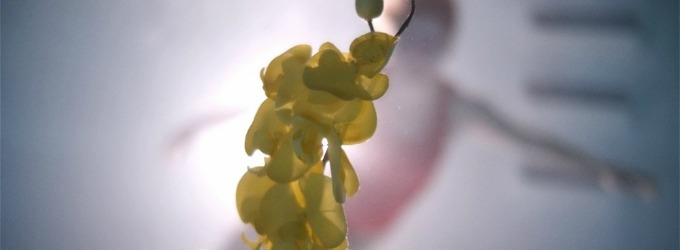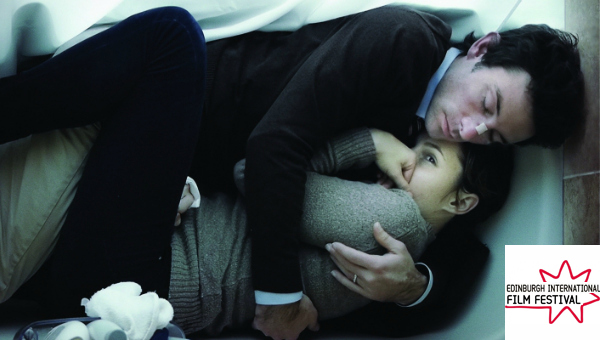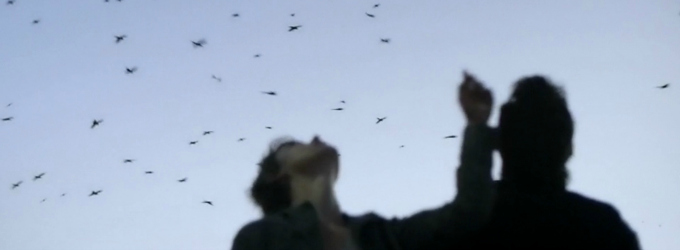 Shane Carruth writes, directs and co-stars in this follow-up to his intriguing low-budget maths-fi time travel film, PRIMER (2004). UPSTREAM COLOR opens with the abduction of a woman called ‘Kit’(played by Amy Seimetz), who becomes involved with the life cycle of a grub which has bizarre effects on anyone who comes into contact with it.
Shane Carruth writes, directs and co-stars in this follow-up to his intriguing low-budget maths-fi time travel film, PRIMER (2004). UPSTREAM COLOR opens with the abduction of a woman called ‘Kit’(played by Amy Seimetz), who becomes involved with the life cycle of a grub which has bizarre effects on anyone who comes into contact with it.
There follows some squirm-inducing body horror, the marvellously tactile field recording expeditions of a pig farmer, and the bulk of the film itself; which concerns the romance between Kit and another abductee, Jeff (Shane Carruth). The empathic properties of the grub are hinted at in an engrossing beginning where we see its effects taking hold on some teens that use it as an intoxicant. It leads to them mirroring each other’s actions in an uncanny way, and there’s a sense of nostalgic adolescent wonder, of youth and possibility, enhanced by the warmly-lit suburban setting.
A richly detailed, likeably pretentious work…
The most powerful moments are undoubtedly the ones concerning Kit’s abduction and subsequent incubation of the grub. It has the effect of making her suggestible to the point of being unable to function without someone’s commands. This suggestibility is such that her perceptions of reality are skewed by her literal responses to her captor’s often baffling commands. Kit is made to complete an abstract series of repetitive, functionally useless tasks in order to receive a deceptively pleasurable reward, in a way that could be read as an othering of Obsessive/Compulsive Disorder, an ‘insight’ into the working world, or just as a comment on the subjective, mutable nature of everyone’s individual reality. These scenes are troubling: this absolute erasure of someone’s personality and free will for the benefit of another is unsettling and frustrating, especially as it’s within a male/female power dynamic.
Slowly coming to terms with their past trauma, and how the emotional beats of their relationship relate to events surrounding the continued life cycle of the parasitic grubs, the film addresses the nature of how personality is constructed, the tactile and aural triggers of memory and how this relates to a sense of self. While these are valid and interesting themes, any real insight is undercut by the lack of chemistry between the two leads, their relationship never feeling like it transcends their shared parasitic bond; Carruth in particular seeming cold and stilted. During the parts which focus on this relationship, the film starts to lose steam. It’s hard to be swept along by the meandering events of their time together, after such a strong start.
Carruth does sometimes cross the line into ‘perfume advert’ territory…
A major strength of UPSTREAM COLOR is that the viewer is invited to make multiple readings of the film. It seems tailor-made for repeat viewings, with a fair amount to unpack and decipher in its sometimes collage-like structure. A richly detailed, likeably pretentious work, Carruth does sometimes cross the line into ‘perfume advert’ territory; some faux-profound dialogue and clumsy juxtaposition of images making it a little too easy to mock. Fittingly in that respect, it shares some atmospheric similarities with Richard Kelly’s body of work, as well as his unapologetically po-faced embrace of the fantastic.
UPSTREAM COLOR is rarely less than interesting, and whilst its mix of body horror, romance and philosophy isn’t perfect, it’s an ambitious, rewarding film that stays with you beyond the rather twee end credits.
UPSTREAM COLOR screens on 19 September at 22.30 at Cambridge Arts Picturehouse.
httpvh://youtu.be/SilYsr_3vrA


